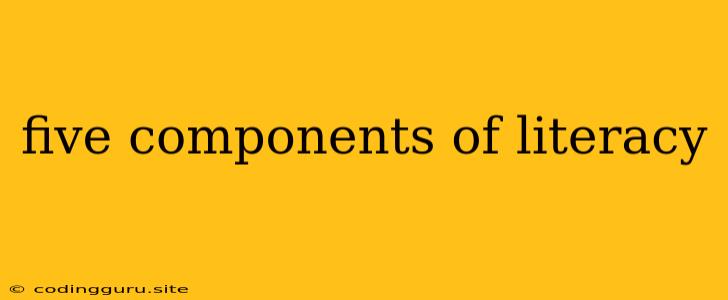The Five Pillars of Literacy: Understanding the Building Blocks of Reading and Writing
Literacy is a fundamental skill that underpins our ability to navigate the world around us. It is not merely the ability to read and write, but rather a complex tapestry woven from five crucial components. These components, when developed together, empower individuals to understand, interpret, and create meaning through language.
What are these five components? Let's delve deeper into each one:
1. Phonemic Awareness: The Foundation of Reading
Phonemic awareness is the ability to hear, identify, and manipulate individual sounds (phonemes) in spoken language. It's like being able to take apart a word, like "cat," and hear the individual sounds /k/ /æ/ /t/. This skill is essential for learning to decode words and understanding the relationship between sounds and letters.
How can you foster phonemic awareness in children?
- Play rhyming games: This helps children recognize similar sounds in words.
- Sound out words together: Break down words into their individual sounds, emphasizing each one clearly.
- Use picture cards with words: Have children identify the initial sound in each word.
2. Phonics: Connecting Sounds to Letters
Phonics is the bridge between spoken and written language. It teaches the relationship between letters and their corresponding sounds, allowing individuals to decode words and sound them out.
How can you improve your phonics skills?
- Learn the alphabet and the sounds each letter makes.
- Practice blending sounds together to form words.
- Read aloud and point out letter-sound correspondences.
3. Vocabulary: Building a Rich Language Base
Vocabulary refers to the words we know and understand. A robust vocabulary is essential for comprehending text, expressing thoughts effectively, and engaging in meaningful conversations.
How can you expand your vocabulary?
- Read widely: Encountering new words in context helps you understand their meaning and usage.
- Use a dictionary and thesaurus: Look up unfamiliar words and explore their synonyms and antonyms.
- Engage in conversations: Discussing ideas and concepts helps you acquire new vocabulary naturally.
4. Reading Fluency: Reading with Speed and Accuracy
Reading fluency is the ability to read text at an appropriate pace and with accuracy, allowing for comprehension and enjoyment.
How can you improve your reading fluency?
- Practice reading aloud regularly: This helps you build speed and accuracy.
- Choose books at your reading level: This ensures you can read without stumbling and frustration.
- Use a timer to track your reading speed and monitor progress.
5. Reading Comprehension: Understanding What You Read
Reading comprehension is the ultimate goal of literacy. It's the ability to understand and interpret the meaning of what you read, drawing inferences, making connections, and remembering key details.
How can you improve your reading comprehension?
- Ask yourself questions about the text.
- Summarize the main points in your own words.
- Make connections between the text and your own experiences.
The Importance of the Five Components of Literacy
Each component of literacy builds upon the others, forming a solid foundation for lifelong learning and success. Without a strong base in phonemic awareness, phonics, and vocabulary, reading fluency and comprehension will be difficult to achieve.
Imagine trying to build a house without a strong foundation. The walls would be unstable, and the roof might collapse. Similarly, without the foundational skills of literacy, reading and writing will be challenging and ultimately hinder an individual's ability to succeed in school, at work, and in life.
Developing the Five Components: A Lifelong Journey
The five components of literacy are not isolated skills but rather interweaved aspects of a complex system. As we progress through life, we continuously refine and enhance our abilities in each area.
For children, early intervention is crucial. Engaging them in activities that foster phonemic awareness, phonics, and vocabulary development lays the groundwork for a successful literacy journey.
For adults, ongoing learning is essential. Maintaining a strong vocabulary, engaging in reading for pleasure, and developing fluency through consistent practice ensures that we remain engaged and effective communicators.
Conclusion
The five components of literacy – phonemic awareness, phonics, vocabulary, reading fluency, and reading comprehension – are the building blocks of successful reading and writing. By fostering these skills in children and nurturing them in adults, we empower individuals to navigate the world with confidence and achieve their full potential. Remember, literacy is not just about reading and writing; it's about unlocking the doors to knowledge, understanding, and a richer, more fulfilling life.
